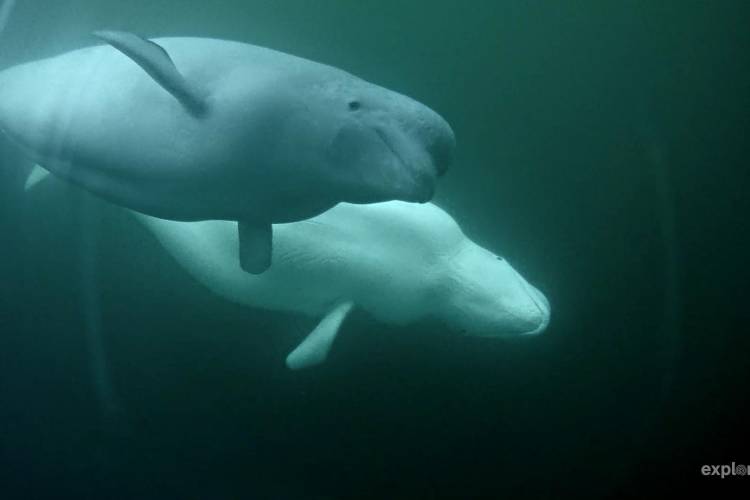Q: Where are you testing the systems?
A: We decided that Churchill, Manitoba, Canada, the polar bear capital of the world, would be the perfect test site for several reasons. First, polar bears gather near Churchill every fall as they wait for the sea ice to return. So, we knew we would reliably have polar bears to test there. Second, we already have vast infrastructure in place in Churchill to power our Polar Bear Cams and Tundra Connections® webcasts. Knowing we’d be able to piggyback on that—both the wireless and bandwidth—was a big plus. And, finally, the town of Churchill supported the idea and welcomed our team.
Q: Can you tell us more about the four radar systems? What are the differences?
A: The SpotterRF mentioned earlier is a medium-range system that can survey a wide area. We’re now in our third year of testing it. In 2020, we were able to program an AI component of the Spotter to test whether the system could tell the difference between a polar bear and other movement on the landscape. In 2021, we built on those results by evaluating how well the system classifies targets. Basically, we’re looking at whether it can tell a polar bear from a human walking or a caribou grazing.
Our research so far shows that these devices are highly effective in detecting polar bears, even in blizzard conditions or at night. Our goal is to fine-tune the AI to correctly identify polar bears, triggering an alert before they hit the first road or the edge of town.
But the SpotterRF is a more complex system, and also more expensive, making it best suited for use by communities. So, this year, in partnership w/ Brigham Young University, we also tested Lidar, a simpler short-range ground-based radar. It’s easier to use and costs less. While it doesn’t have the wide range of the SpotterRF, it shows great promise for use at campsites or on small cabins.
In addition, engineers from a German company that produces a high power, long-range X-band radar, heard about the work we are doing and reached out to donate both time and equipment to test the effectiveness of their system in detecting bears. They sent two engineers to Churchill this fall who worked with our team.
And, finally, we worked with the engineering department at Ohio State University on testing a short-range, mixed-sensor radar that could provide an electronic fence around a camp or community. This system is easy to operate, cost effective, and shows great potential. Our team feels fortunate to be able to test multiple radar systems to see which ones work best in Arctic conditions and in which situations.
Q: Churchill already has a robust Polar Bear Alert Program. How do these radar systems fit into that?
A: Manitoba’s conservation officers do an amazing job of spotting approaching bears and responding to reports from citizens, but human patrols can be limited by darkness, foggy weather, or whiteout snowstorms. Ground-based radar systems could complement the efforts of Churchill’s Polar Bear Alert officers, sending an alert of an approaching bear and giving officers time to respond in a non-lethal manner. These systems could also help other northern communities that don’t have the resources for human patrols, in addition to protecting campsites and workstations.
Q: What did you learn this fall? What are the next steps?
A: We are learning a little from each of our radar partners. The SpotterRF system is teaching us about the important role AI can play in reducing false alarms and correctly classifying targets. The Brigham Young University system is teaching us how custom-built software that combines multiple data streams into one easy-to-use interface can save time and money. The German system is showing us how well-designed systems can be set up very quickly, even if weather is making life difficult. And the Ohio State University team is helping us learn about energy efficiency and the role many small sensors can play as a community protection tool.
Q: Is there anything else you’d like to add about the project?
A: We’ve had a lot of interest in the radar systems from wildlife managers in northern communities. And beyond the community safety aspect, there’s a pretty interesting science story. The radar collects geospatial data, location, and speed—data that could potentially help with other studies.
Special thanks to RBC Tech For Nature for their generous grant of $75,000 CAD that served as seed money for our expanded Detect and Protect project. Thanks, too, to Utah’s Hogle Zoo for funding the pilot program, to individual donors who supported our Polar Bear Week fundraiser in support of the project, and to our various partners: Brigham Young University, Ohio State University, and SpotterRF.
In addition, we’re grateful to NMS Security for help with installing the SpotterRF, and to Milestone Systems, which analyzes the live streams through its surveillance system. And, finally, special thanks to the town of Churchill for their cooperation during the test phase of the project, to Frontiers North Adventures for allowing us to mount a device on the Tundra Buggy Lodge, and to Amy Cocksedge of York University for making the concept the focus of her master’s thesis.

















